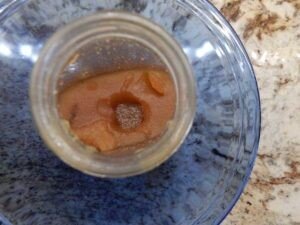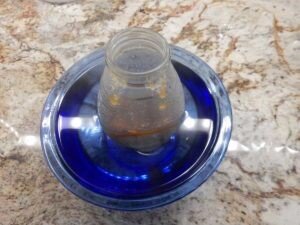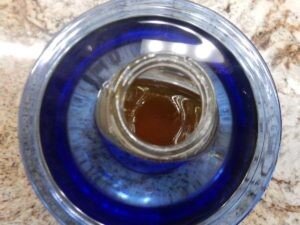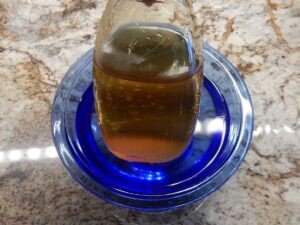Reference for Below Content:
All rights to and the content of the following decraystallization of raw honey are from the Ashville Bee Charmer ® website (located here https://ashevillebeecharmer.com/honey-tips/how-to-decrystallize-raw-honey/). My purpose for re-posting this article directly on the Honey So Good ® Apiary website is purely for reference as I felt the information was well present and any paraphrasing of the work would simply take away from its quality. Please reach out to the source owner for any questions or rights related to the material.
From the Asheville bee Charmer® web site:
“HOW TO DECRYSTALLIZE RAW HONEY WHILE RETAINING QUALITY AND FLAVOR
Did your jar of honey crystallize? This is totally normal, and natural. Crystallized honey is just as edible and delicious as liquid honey, but if you don’t like the texture of crystallized honey, it is quite simple to soften honey by adding heat.
Heating honey will liquefy crystallized honey. But bee careful. If you overheat the honey during the decrystallization process you risk changing the quality and losing raw honey nutrients and benefits.
To preserve the best qualities of that raw honey, you must melt it slowly in a glass jar using low, indirect, and constant heat for as long as the honey takes to decrystallize.
Decrystallize honey in 4 steps
Step One: Place glass jar of honey into a larger glass or ceramic bowl (if your honey comes in a plastic bottle spoon out crystallized honey into a sealable glass jar” Note from HoneySoGood®Apiary - A plastic jar will work too, however, plastic is a much better insulator than glass, so it will take longer, using an insulated contain to hold the warm water would be preferable in this case. “).
Step Two: Heat a pot of water up to a temperature between 95°F and 110°F. You can create this warm water bath using a kettle, instant pot, or, if you want precision, a sous vide cooker.
Step Three: Pour the warm water bath into the bowl and jar of honey is sitting in. Make sure the water line is above the level of the honey but below the lid. You do NOT want water to accidentally get into your honey jar or container.
Step Four: Leave the jar of honey sitting in the bath, stirring occasionally, until the honey reliquifies. Monitor the water temperature with a thermometer and adjust by adding hot or cool water to keep it at or below 110°F.
The length of time that your honey will take to decrystallize depends upon the amount you are liquefying, but a typical honey jar takes a little over an hour to decrystallize.
WHY DOES HONEY CRYSTALLIZE?
Pure, raw honey crystallizes naturally over time as the sugar “precipitates out” of the solution into crystal form. Honey is made up of glucose and fructose. Different honey varietals have different ratios of these sugars, which means different honeys crystallize at different rates.
The higher the glucose, the faster a honey will crystallize. These include:
· Dandelion honey
Honeys that are higher in fructose than glucose crystallize more slowly. These include:
Remember, crystallized honey has not spoiled! Honey does not go bad, and crystallized honey still has the same quality and flavor, just maybe a different
DECRYSTALLIZATION: A “HONEY-DON’T” LIST
Don’t microwave raw honey to decrystallize it. Microwave ovens cook food unevenly (that is why you have to turn your microwave dinner halfway through the cycle). You can’t control the temperature at all and are likely to scorch or boil at least some of your raw honey in a microwave.
Don’t boil raw honey. You may be tempted to immerse your entire honey jar in boiling water, but that will destroy beneficial enzymes and other properties found only in raw honey.
Don’t heat honey in a plastic bottle. Don’t take the risk that you’ll melt plastic into your honey.
Don’t liquefy honey over and over again. Decrystallize only what you need at one time. The flavor and aroma of the honey will fade with repeated cycles of heating and cooling (and liquefying and crystallizing).
Bottom of Form
WHAT HAPPENS WHEN YOU OVERHEAT RAW HONEY
Whether you buy raw local honey for the benefits of the pollen or if you are a gourmand with a taste for the world’s most delicious raw honey, you have excellent reasons to take extra care when decrystallizing your honey.
Pollen, propolis, antioxidants, and enzymes found in raw honey are destroyed at temperatures above 110°F. Heating honey higher than 140°F degrades the quality of the honey and temperatures above 160°F caramelize the sugars. Once caramelized, what you have in your honey jar may be sweet, but it isn’t really honey anymore.
The boiling point of water is 212°F. If you really want to preserve your raw honey while decrystallizing it, you can’t just drop the jar in boiling water. Most residential hot water heaters are set to 140°F, so even tap water will need to be monitored closely with a thermometer if you are using it to decrystallize honey.”
All rights to and the content of the following decraystallization of raw honey are from the Ashville Bee Charmer ® website (located here https://ashevillebeecharmer.com/honey-tips/how-to-decrystallize-raw-honey/)




